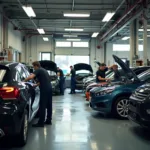Starting out with car body repairs can seem daunting, but with the right guidance and a little patience, even beginners can achieve impressive results. This guide will provide you with the essential knowledge and practical tips to confidently tackle those minor dents, scratches, and imperfections that can mar your car’s appearance.
Understanding the Basics of Car Body Repair
Before diving into the practicalities, it’s essential to understand the basic structure of a car’s bodywork. The outer layer, typically made of steel or aluminum, is known as the panel. Beneath this lies a primer coat, followed by the base coat (the color of your car), and finally, a clear coat for protection and shine.
Most minor car body repairs involve fixing damage to these outer layers, and while some cases might require professional intervention, many can be tackled at home with readily available tools and materials.
Essential Tools and Materials
Having the right tools and materials is crucial for successful car body repairs. Here’s a list of essentials for beginners:
- Cleaning Supplies: Car wash soap, microfiber cloths, wax and grease remover
- Sanding Supplies: Sandpaper (various grits), sanding block, tack cloth
- Body Filler: For filling dents and scratches
- Putty Knife: For applying and smoothing body filler
- Primer: For preparing the repaired area for painting
- Paint: Touch-up paint that matches your car’s color
- Clear Coat: For protecting the paint and adding shine
- Masking Tape and Paper: For protecting areas you don’t want to paint
- Safety Gear: Gloves, safety glasses, and a respirator
Common Car Body Repairs for Beginners
Now, let’s delve into some common car body repairs that beginners can tackle:
1. Removing Minor Scratches
Shallow scratches that haven’t penetrated the primer can often be removed with polishing compound.
- Step 1: Clean the scratched area thoroughly.
- Step 2: Apply a small amount of polishing compound to a clean microfiber cloth.
- Step 3: Rub the compound onto the scratch using a circular motion, applying moderate pressure.
- Step 4: Wipe away any excess compound and inspect the scratch. Repeat if necessary.
car body repair accesories ib yeovil somerset
2. Fixing Small Dents
For minor dents without paint damage, you can try the “paintless dent repair” (PDR) method using a hairdryer and compressed air.
- Step 1: Heat the dented area with a hairdryer for a few minutes.
- Step 2: Immediately spray the heated area with a can of compressed air (turned upside down).
- Step 3: The rapid temperature change can cause the dent to pop back out.
Expert Insight: “PDR works best on shallow dents that haven’t creased or damaged the paint,” says Mike Johnson, a seasoned auto body technician. “If the dent is severe or the paint is cracked, it’s best to seek professional help.”
3. Repairing Scratches that Have Penetrated the Primer
Deeper scratches require a multi-step approach involving sanding, priming, and painting.
- Step 1: Clean the area and sand down the scratch with progressively finer grits of sandpaper.
- Step 2: Clean the area again and apply primer to the sanded area, allowing it to dry completely.
- Step 3: Lightly sand the primed area and clean it thoroughly.
- Step 4: Apply touch-up paint in thin coats, allowing each coat to dry before applying the next.
- Step 5: Once the paint is dry, apply a clear coat to protect it and enhance the shine.
car body paintless dent repair tools
4. Filling and Repairing Deeper Dents
For deeper dents, you’ll need to use body filler.
- Step 1: Clean and sand the dent and the surrounding area.
- Step 2: Mix a small amount of body filler according to the manufacturer’s instructions.
- Step 3: Apply the filler to the dent using a putty knife, overfilling slightly.
- Step 4: Allow the filler to harden and then sand it down until it’s flush with the surrounding bodywork.
- Step 5: Prime, paint, and clear coat the repaired area as described in the previous steps.
Conclusion
Tackling car body repairs as a beginner can be a rewarding experience, saving you money and giving you the satisfaction of restoring your car’s appearance. Remember to start with small, manageable repairs and gradually work your way up to more challenging tasks. By following the tips and techniques outlined in this guide and using the right tools and materials, you can achieve professional-looking results. And remember, safety should always be your top priority. Happy repairing!

